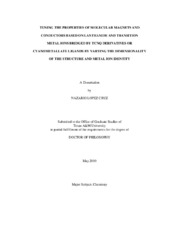| dc.description.abstract | Research in the fields of molecular conductors and magnets over the past four decades has involved collaborative efforts of chemists and physicists whose common goal is to design useful materials composed of molecular building blocks. Of particular interest are materials whose properties can be tuned by electronic or steric changes in the molecular sub-units. The research on TCNQ derivatives described in this thesis was inspired by the observation that, although a vast amount of research has been directed at understanding binary M(TCNQ•-) materials, analogous compounds based on substituted TCNQ acceptors are surprisingly scarce. Single crystals of a new structure type for the M+(TCNQ)•- binary family were isolated from reactions of two dihalogenated TCNQ derivatives with Cu(I) ions, namely Cu(TCNQX2) (X = Cl, Br). The new 3-D compound Cu(TCNQCl2) exhibits the highest conductivity of the M+(TCNQ)•- series to date, despite the greater separation of TCNQCl2 units as compared to other derivatives. Compounds of lower dimensionality were also obtained, namely the 2-D Cu(TCNQBr2)(CH3CN) and 1-D Cu(TCNQI2)(CH3CN)2 phases. Several 2p-3d heterospin molecular magnets were also synthesized. For example a “magnetic sponge” material based on a 2-D hexagonal framework of composition {[Mn2(TCNQF4)(CH3OH)7.5(H2O)0.5]-(TCNQF4)2•7.5CH3OH}∞, as well as molecular magnets based on first row metal ions and TCNQF4 ligands of composition MII(TCNQF4)-•(TCNQF42-)0.5(CH3CN) (M = Mn, Co) were prepared. In addition, unprecedented isostructural 2-D frameworks based on combinations of first row metal ions with TCNQBr2 radicals of composition [M(TCNQBr2)2(H2O)2]∞ (M = Mn, Zn) were synthesized.
Lanthanide chemistry is also described in this dissertation. A series of mononuclear Ln-TCNQF4 heterospin complexes of composition {MIII[TCNQF4]2[H2O]x}(TCNQF4)(3H2O) (M = La, Pr, Nd, Sm, Eu, Gd, Dy, Ho, Er and Yb) was also obtained which exhibit remarkable properties. In this family of compounds there exists an unprecedented subtle interplay between single molecule magnetic behavior and phonon bottleneck effect behavior for the Tb analogue. Magnetic ordering was observed for the Sm analogue. A homologous series of 1-D materials based on alternating lanthanide ions and hexacyanometallates of formula {[Ln(tptz)(H2O)4Fe(CN)6]•8H2O}∞ (Ln = Pr, Nd, Sm, Eu, Gd, Tb) was obtained and a detailed magnetic study provided incontrovertible evidence that the SmIII-[FeIII(CN)6]3- compound exhibits ferromagnetic and not antiferromagnetic coupling as had been reported for related 1-D chains. | en |


